|
< Earlier Kibitzing · PAGE 2 OF 3 ·
Later Kibitzing> |
| Feb-10-11 | | CommaVid: Notice that in this position, after 60. Kb5, black would have an inmediatly draw with Nxd6+ IF black's b-pawn wasn't there (Nxd6+ Bxd6 Kb6 =), however since b-pawn is there this trick doesn't work now since after Nxd6+ Bxd6 Kd7 (b6?? Kxb6  ) Bh2 Kc8 Kb6 h4 Bf4 h3 Bh2 black is in zugzwang and must release the b-pawn and will lose. Interesting endgame. ) Bh2 Kc8 Kb6 h4 Bf4 h3 Bh2 black is in zugzwang and must release the b-pawn and will lose. Interesting endgame. |
|
| Feb-10-11 | | LoveThatJoker: <mike1> Hey man, good analysis! You're absolutely right that Black should only be playing for a draw in this endgame. 58...Nd2? is indeed a weak move. I was playing through your ideas and it suddenly dawned upon me that, starting from move 57, Black could even have played to sac his N at some point: Going for a classic wrong Rook's pawn position. Conditions would have needed to be favourable for this of course. (Note that in regards to the N sac I'm talking about lines starting from 57... Not the game continuation where 60...Nxd6?? would have been an unfortunate blunder. I saw this in my analysis, but am glad that <Commavid> posted regarding this). However, the MAIN plan for Black would have involved the N manoeuvring smartly to the center area so as to create decisive threats on White's d-pawn. Repetition of moves being the probable outcome. Outside of this, I'm thinking that 58. a5 was on the dubious side. Aside from a Bishop tempo move (probably better still), it is hard to suggest an improvement for White. I say that 58. a5 was somewhat dubious because it allows the tactic you mentioned of Kxb7 Nxa5+. However, the thing is that even with the pawn on a4, Black would in many lines have the resource Kxb7 Nc5+ capturing on a4. Good on you for finding new things in the game. Good insight! LTJ |
|
| Feb-10-11 | | smitha1: This position is won for white because of Black's overworked b Pawn watching a6 and c6. That to my mind is unusual: work and the b Pawn do not go into the same sentence. The f, g and h Pawns shelter the King, the c, d, and e Pawns fight for the centre. The a Pawn (as in this game) is the sneak that races for promotion when the opposition is not watching. But the b Pawn, humblest of the humble, has no such role. Some gambits are even designed to liquidate this fellow in return for a greater but intangible benefit. But every now and then this little Pawn makes the difference between winning and losing. There must be some allegory there... |
|
| Feb-10-11 | | David2009: C Sandipan vs F Slingerland, 2008 White 61? Black to play may or may not be able to draw with Nf5 etc (chess is sometimes a difficult game) but since it is White's
move 61 a6! wins immediately. The threat is a7 promoting; 61 bxa6+ 62 Kc6 promotes the other Pawn. Best OTB seems 62...h4!
which may confuse White, but the win is there after both 63 Bxh4 and 63 a7. OTB I would choose Bxh4: am I right?
Time to check:
====
Crafty End Game Trainer defends 61 a6 with 61...bxa6+ 62 Kc6 Nf5 63.d7+ Kd8 64.Bc7+ Ke7 65.d8=Q+ 1-0
After 61 h4 we reach
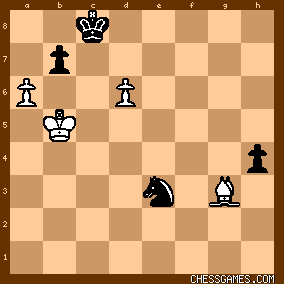
click for larger view
and now both a7 and Bxh4 defeat the EGT. Link: http://www.chessvideos.tv/endgame-t... <Phony Benoni: [snip] There's a fascinating ending in the database--might be a Louis Paulsen game--that shows a subtle way of winning with the wrong colored rook pawn. I thought of looking for it, but now it seems irrelevant.>
If Black plays differently and weakly with 61...Nf5 62.Bh2 Nxd6?? (62...Kd7 draws) 63.Bxd6 
click for larger view
and captures the g7 Pawn by zugzwang. |
|
| Feb-10-11 | | patzer2: White's 61. a6! solves today's Thursday puzzle because after 61...bxa6+ 62. Kc6  the passed pawn is unstoppable. the passed pawn is unstoppable.Not capturing the pawn is not an option, since White just pushes and promotes to a Queen if Black doesn't take it. P.S.: I went for 61. Kc5?, making the same mistake as White in this game of trying to obey the old maxim of "keeping passed pawns under lock and key." However, my Fritz program didn't take more than a second to calculate the winning 61. a6!, since it isn't constrained by keeping any such general rules for playing chess in mind. Instead, it can rely only on raw computing power, which in this case is an advantage. |
|
| Feb-10-11 | | DarthStapler: I at least considered the first move |
|
| Feb-10-11 | | LoveThatJoker: ADDENDUM (for the sake of thoroughness): <mike1> Hey man, good analysis! You're absolutely right that Black should only be playing for a draw in this endgame. 58...Nd2? is indeed a weak move. I was playing through your ideas and it suddenly dawned upon me that, starting from move 57, Black could even have played to sac his N at some point: Going for a classic wrong Rook's pawn position. Conditions would have needed to be favourable for this of course - i.e., White would have to cooperate! (Note that in regards to the N sac I'm talking about lines starting from 57... Not the game continuation where 60...Nxd6?? would have been an unfortunate blunder. I saw this in my analysis, but am glad that <Commavid> posted regarding this). However, the MAIN plan for Black would have involved pushing the h-pawn as far as possible coupled with either: a) Manoeuvring the N smartly to the center area so as to create decisive threats on White's d-pawn OR b) Keeping the N in the vicinty of b3 while waiting for the perfect moment to trade his b-pawn for White's a-pawn with a draw. Outside of this (yet still somewhat related), I'm thinking that 58. a5 was on the dubious side. Aside from a Bishop tempo move (probably better still), it is hard to suggest an improvement for White. I say that 58. a5 was somewhat dubious because it allows the tactic you mentioned of Kxb7 Nxa5+. However, the thing is that even with the pawn on a4, Black would in many lines have the resource Kxb7 Nc5+ capturing on a4. Good on you for finding new things in the game. Good insight! LTJ |
|
| Feb-10-11 | | CHESSTTCAMPS: In this endgame, the pawn count is even, but the winning advantage goes to the advanced passed d-pawn and the long-range bishop, which can both support the white passed pawn and defend the black passed pawn without assistance. Promoting the d-pawn requires control of d7, which can only be done by the white king. Therefore, white must remove the b7-pawn to enable Kc6. 61.a6! overburdens BK and BN, forcing a pawn through: A) 61... ba+ 62.Kc6 Nf5 63.d7+ Kd8 64.Bc7+ wins
B) 61... Kb8 62.e7+ wins.
C) 61... Nf5 62.a7 Nxg3 68.a8=Q+ Kd7 69.Qb8 and the d-pawn also promotes, not even allowing Q v N ending. From the diagram, black to move would ensure no worse than a draw with 61... Nf5 62.Bh2 h4 63.Kc5 (a6 ba+ 64.Kc6 Nxd6) h3 followed by 64... Kd7. |
|
Feb-10-11
 | | Phony Benoni: The full game is not available in the database, but here's the endgame I was thinking of: <Metger v. L. Paulsen>, Nuremberg, 1888
<WHTIE TO PLAY>
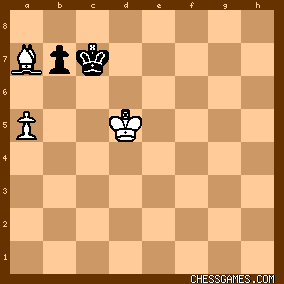
click for larger viewThe game was agreed drawn at this point, but a win was later found for White. If you found today's puzzle to be too easy, give this a shot. |
|
| Feb-10-11 | | 1.e4effort: Move 61. - white to move. This looks like a draw, but if I'm white I want to win from this position, but advancing (i.e., sacrificing) my d pawn with check is fruitless, and my Bishop is the wrong color, and becuase of black's pawn on the h file, he's destined to live on the h2-b8 diagonal. If I'm black I have a little more freedom of movement with my Knight, but I don't see a win. What say we draw and set the pieces up again? |
|
| Feb-10-11 | | Marmot PFL: the key must be to get the WK to c6 in support of the d-pawn, so 61 a6 looks correct -- ba6 (forced or a7 wins) 62 Kc6 then d7+ Kd8 and either Bc7+ or Bh4+ wins, and black can't prevent both. |
|
| Feb-10-11 | | Marmot PFL: Very surprised this was drawn. Not in an amateur game, but a near 2600 should see this blindfolded. |
|
Feb-10-11
 | | NM JRousselle: Consul: Here is analysis supporting 45... Nd2
45... Nd2 46 Bd8 (your move) fg 47 Ba5 Nf3+ 48 Kf4 h5 49 Bc3 g5+ 50 Ke3 Ke7 51 Bb4+ Kd7. When the Black Knight reaches f4, the pawns will roll in. Fritz says that after 46 Bd8, Black has a winning advantage. |
|
| Feb-10-11 | | Brettwith2ts: Shoot.
I saw a6.
I analyzed a6.
I figured out all of the lines from a6.
I discarded a6, because I didn't see the brilliant move ♔c6! after bxa6. Shoot. Here's hoping I won't make that kind of mistake in a tournament... |
|
| Feb-10-11 | | sevenseaman: <<PhonyBenoni> The White pawn must get on to the b-file and B has to be sacked to force Black K out of a8 haven.
click for larger vieww
1. Kc5 b6+(forced, if Black K goes to or c8 White K takes command at b6.) 2. axb6+ K retreats to b7(best), d7 or c8. 3. Kb5 Ka8 4. Bb8 Kb7 5. Kc5 Ka8 6. Kc6 Kxb8 (forced)7. b7 Ka7 8. Kc7 and White wins |
|
| Feb-10-11 | | LoveThatJoker: <sevenseaman> After 2. ab+ Kb7 3. Kb5 Ka8 4. Bb8 Kxb8 secures the draw for Black. This is according to Houdini.
I can't take credit for this.
LTJ
PS. Just so you know the winning idea is 1. Kd4 Kc6 2. Bb6  |
|
| Feb-10-11 | | VincentL: I have looked at this for some ten minutes, and I cannot see the solution. The move may be 61. Kc6, but I fail to see how to win with this. I am not doing well this week; let´s check to see what happened. |
|
| Feb-10-11 | | kevin86: I was looking at d7+ but that went nowhere. The solution is to sac the other pawn. 61 a6 bxa6+ (otherwise white wins by 62 d7+ ♔xd7 63 axb7 and queens) 63 ♔c6 and queens the pawn. or if 61...b6 62 a7 and queens |
|
| Feb-10-11 | | sevenseaman: <<LoveThatJoker> PS. Just so you know the winning idea is 1. Kd4 Kc6 2. Bb6 > Thanks. A learning process for me, I'd appreciate a set of winning sequence. |
|
Feb-10-11
 | | doubledrooks: 61. a6! and after 61...bxa6 62. Kc6 the threat of the d pawn queening is too much for black to handle. |
|
Feb-10-11
 | | Jimfromprovidence: <Phony Benoni> <The full game is not available in the database, but here's the endgame I was thinking of:>
<Metger v. L. Paulsen, Nuremberg, 1888 WHTIE TO PLAY> The only winning move is 1 Kd4. (Thank You Mr. Nalimov).

click for larger viewThe position is quite tricky, but the gist of the position is that every other move by white allows black to force white to take his b pawn and allow black's king to reach the a8 square and white can't promote because he has the wrong colored bishop. One solution is 1 Kd4 b5 2 a6!
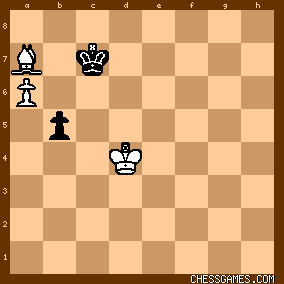
click for larger viewThis line allows white's king to take the pawn and keep the black king away from a8. |
|
| Feb-10-11 | | mecking93: a6! it's the best move and a chess player with 2588 ELO would have to know it. |
|
| Feb-10-11 | | David2009: <Phony Benoni>: Thanks for posting Metger v. L. Paulsen, Nuremberg, 1888 
click for larger view (Metger vs Paulsen 1888 White to play)<Jim: The only winning move is 1 Kd4. (Thank You Mr. Nalimov)> And thank YOU, Jim. Even knowing the first move, I struggled to win against Crafty EGT without looking it up on Nalimov. I SHOULD have been able to work it all out by logic - but I couldn't.Here's the link:
http://www.chessvideos.tv/endgame-t...
Enjoy! and enjoy finding out why the alternative first moves only draw. |
|
| Feb-10-11 | | alachabre: Situational assessment:
Black threatens to fork B and P, not a terrible thing; the B can move and I doubt black will find it worthwhile to give up N for P. However, harassment by the N will allow the h pawn to slowly advance.
White's king can't make progress so long as black's king is camped out on c8.Ok, the only thing that seems to make progress:
61. a6 bxa6
62. Kc6 Nf5
63. d7+ Kd8
64. Bc7+ and queens.
What's the best defense? Clearly 62. ...Nf5 fails.
61. ... Kb8 (or ...Kd8)
62. d7 (a7)
No knight move seems to work on move 62, and any move beside Kb8 or bxa6 allows a7 and queening. So that's it then, 61. a6 |
|
| Feb-10-11 | | LoveThatJoker: <sevenseaman: <<LoveThatJoker> PS. Just so you know the winning idea is 1. Kd4 Kc6 2. Bb6 >
Thanks. A learning process for me, I'd appreciate a set of winning sequence.> Hey man. No problem. All lines are my own with the exception of 1. Kd4 Kc6 2. Bb6 (Houdini)
and
1. Kd4 b5 2. a6 (Jimfromprovidence)
Let's get started:
1. Kd4 Kc6 2. Bb6

click for larger viewVARIATION A: 2...Kb5 3. Kd5 Ka6/Kb4 4. Kd6 Kb5 5. Kc7 Ka6 6. Kc8 winning VARIATION B: 2...Kd7 (trying to run to a8 along the back rank) 3. Kc5 Kc8 (3...Ke8 4. Kd6 wins) 4. Ba7! Kc7 (4...b6+ 5. Kxb6 wins; 4...b5 a6 and we get the position Jimfromprovidence mentioned and wins) 5. Kb5 Kd7! (5...Kc8 6. Kb6 wins; 5...b6 6. a6 wins) Position after 5...Kd7!
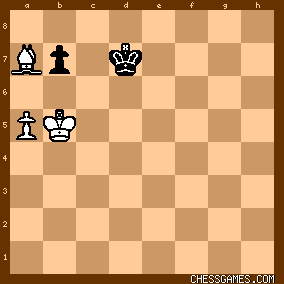
click for larger view6. Bb8!
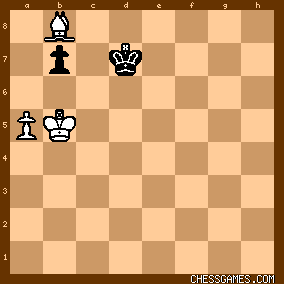
click for larger view(6. Kb6? deserves a question mark as it is inefficient and could potentially be at best a draw as 6...Kc8! stymies any idea of a comfortable win for White; even if White can still win, 6. Kb6? is a bad move) 6...Kc8 7. Bh2! wins
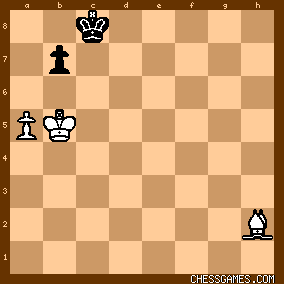
click for larger view(cont.) |
|
 |
 |
|
< Earlier Kibitzing · PAGE 2 OF 3 ·
Later Kibitzing> |





































